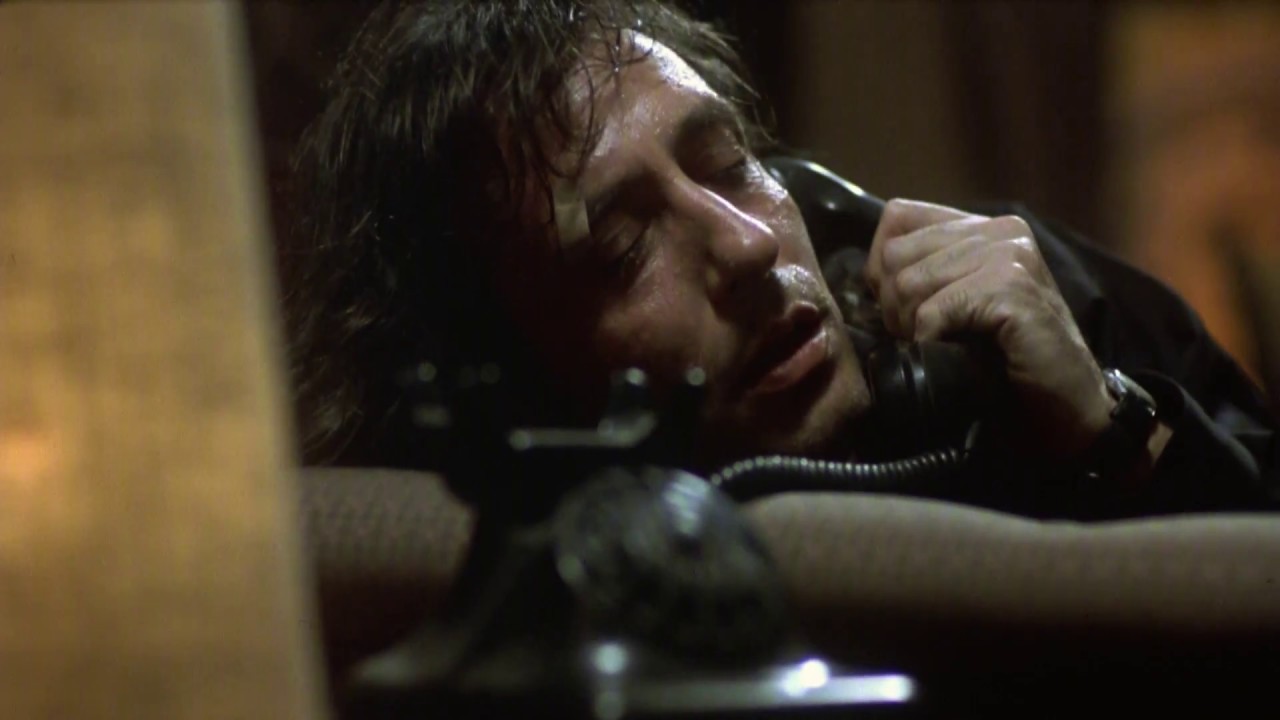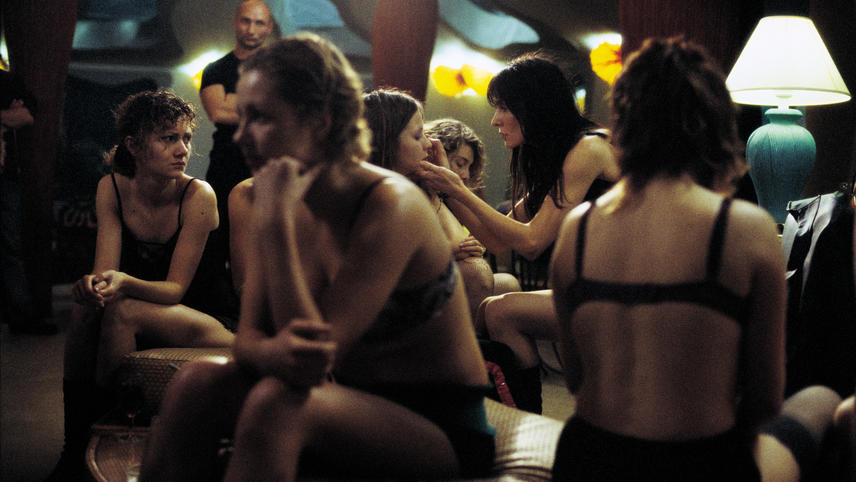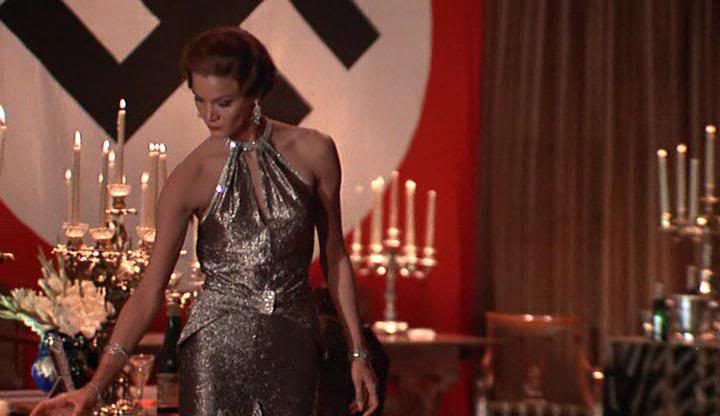9-11. Evrydiki BA 2O37 (1975); The Wretch-es Are Still Singing (1979); Sweet Bunch (1983); Morning Patrol (1987); The Loser Takes It All (2002) Dir. Nikos Georgiou Nikolaidis

The late Nikos Georgiou Ni-kolaidis’s (Νίκος Γεωργίου Νικολαΐδης, 25 October 1939, Athens, Greece – 5 Sep-tember 2007, Athens, Greece) highly experimental feature debut Evrydiki BA 2O37 (Ευριδίκη ΒΑ 2Ο37, 1975) is a disturbing surrealist retelling of some classical mythol-ogy, the story of Eurydice and Orpheus mentioned in Plato’s Symposium [2]. Except that he comes as an angel of death rather than as a savior and is killed by her, a Liebestod akin to 김기덕’s 숨 (2007 i.e. Kim Ki-duk’s Breath, akin to many films listed here).
Featuring a woman trapped in a sort of a hellish jail-cell contraption, set in a dictatorial regime, involving doll-mutilations, anorexia nervosa/bulimia nervosa-induced vomit-ing/emetophilia, graphic masturbation, and much more, all managing to successfully impart upon the viewer her depression almost as harrowingly as Lars von Trier’s Mel-ancholia.
This hidden gem, with a mere 314 votes currently on IMDb, was described by its director, one of those little-known masters of European avant-garde/experimental cinema, as “the solution to many of the problems which puzzled [Pier Paolo] Pasolini’s for years. I am embarrassed because I didn’t know then and I still don’t know anything [about] Pasolini’s problems.” Filmed in fixed tableauxes with few camera movements, Nikolaidis decided to instead focus mostly on what matters, acting.
Nikos Georgiou Nikolaidis’s (Νίκος Γεωργίου Νικολαΐδης) “Years of Cholera” trilogy, whose three films’s English-language titles are The Wretches Are Still Singing (Τα Κουρέλια Τραγουδάνε Ακόμα…, 1979), Sweet Bunch (Γλυκιά Συμμορία, 1983), and The Loser Takes It All (Ο χαμένος τα παίρνει όλα, 2002) and whose three films currently sport a measly 742, 1,051, and 1,081 votes on IMDb respectively, again deals with some sort of a serial-killer/rapist/necrophile (plus a great many other indulging in all sorts of crimes).
These could be best described as a more violent, dis-turbing, and sexualized rendition of John Cassavetes’s dealings with macho immaturi-ty, maudlin self-aggrandizing brouhaha, states of middle-aged emotional confusion or adolescent-like nostalgia for an imagined lost youth, and self-deceiving masks one wears so tightly they become more important than what is beneath them in his films such as Faces (1968).
Sweet Bunch has been described by Nikolaidis as “like an un-known melody that you can feel coming back from the early years of your life[, a]t times you think you know what it is and start to whistle it slowly, then after a while, it slips away leaving you disappointed[, t]hen you suddenly wake up one night, feeling certain this time, that you’ve really captured it, only to wake up the next morning without being able to tell if it was reality or just a dream.”
And he succinctly later de-cided to describe The Loser Takes It All as being most concerned with a “generation that’s growing up within the loneliness of its self-knowledge, looking for values in the past, and trapped in a pointless anticipation of ‘messages’ and ‘exits,’ which are ob-structed and lead nowhere. I‘m interested in the uncertainty the heroes have, which in turn becomes a ‘stance’ of life[, t]he trap that is laid before them and the romanticism they use to avoid it, in how they laugh at themselves and the establishment, in their beliefs of love and companionship as well as their beliefs of love for companionship[, t]he brave way they defy even their own ‘Self’ [which] rebels against factionalism and the imposition of stereotypical behaviour [even] if some of them manage to find ca-tharsis through a holocaust, it’s just another sign of hope[, t]his movie is dedicated to all those kids that come down from the hills at night and walk around the dark alleys of our city.”
Nikos Georgiou Nikolaidis’s (Νίκος Γεωργίου Νικολαΐδης) subtlest film, whose English-language title is Morning Patrol (Πρωϊνή Περίπολος, 1987) and which currently sports only 541 votes on IMDb, is, speaking only comparatively of course, the “calmest” of all his films.
Its minimalistic cast is mostly concerned with a woman suffering from amnesia wandering around a deserted post-apocalyptic township all-the-while looking for love, eventually locating some sort of guide, who will teach her about the connection between love and death, to lead her through the dangerous traps set by a paramilitary force attempting to evacuate the survivors.
With haunting shades occasionally reminiscent of Андрей Тарковский’s films and especially Сталкер (1979 i.e. Andrei Tarkovsky’s Stalker). The director called it “a movie that still scares me and I avoid watching it. I believe that it is a film ahead of its time just like Evrydi-ki BA 2O37 [Ευριδίκη ΒΑ 2Ο37] was.”
12. Promised Land (2004, Amos Gitaï)

Amos Gitaï’s (עמוס גיתאי) Promised Land (הארץ המובטחת, 2004), which, criminally, has only 461 votes on IMDb as of this writing, stars Rosamund Pike, one of the most beautiful women in the world, in her breakthrough-role before she became a household-name A-lister, plus several other amazing performances by such mainstays of European cinema as Hanna Schygulla and Anne Parillaud, not to mention great Israeli actors.
A gritty and shocking portrayal of Bedouins trafficking in Eastern European prostitutes in brothels in Israel’s southern Negev deserts, viewers brave and curious enough should again contact the good peo-ple at Third Ear if they search for English-subtitled legal DVDs. Mr. Gitaï is Israel’s most modernist filmmaker and has been called “Israel’s one-man new wave.”
13. A Woman’s Case (1969, Jacques Mory-Katmor)

The late Jacques Mory-Katmor (ז׳אק מורי־קתמור, 4 September 1938, Cairo, Egypt – 6 September 2001, Tel Aviv-Yafo, Israel) was a mainstay of bohemian 1960s counterculture/psychedelic-drug-addled anarchist commune/free-love Israel.
Largely forgotten (mainly because his sole film, which has only 63 votes on IMDb, was a total commercial flop) today even in his home country, he died a tragic drug- and alcoholism-related death liv-ing/squatting in abject poverty with little family.
His highly experimental sole feature, whose English-language title is A Woman’s Case (מקרה אישה, 1969), signifies the be-ginning of art, avant-garde/experimental, and independent cinema in Israel, the New Sensitivity movement – strictly speaking, there was very little cinema, to say nothing of avant-garde/experimental, and independent cinema, in Israel prior to the late-1960s or so – and remain one of its best films ever. Sexually-frank – for its time, definitely, and maybe even by current standards, too – it stars the very beautiful Helit Yeshurun and Ann Tochmeyer (Mory-Katmor’s then- and future-wives, both models as well as it-girls originally).
And it tells of an advertiser meeting a model, leading her into cafés and drug-fueled orgies, and eventually strangling her to death during a sadistic domi-nation/submission session act. Viewers brave and curious enough should, once again, contact the good people at Third Ear if they search for English-subtitled legal DVDs.
14. Les Rendez-vous d’Anna (1978, Chantal Anne Akerman)

“Anna does not express her feelings through dialogue but through action or nonaction, or by simply listening to others—her reserve is a protective shell against an alien world. Akerman further represents this estrangement by situating Anna in stark environments: she is traveling through northern Europe on a tour to promote her latest film, and Akerman shoots every city and town she visits as if it were the same arid no-wheresville[, through] Anna’s meetings, whether with a one-night stand (Helmut Griem), an ex-lover (Jean-Pierre Cassel), or her mother (Lea Massari), we begin to piece together the details of her life and her profound disconnection from everyone and everything. Les Rendez-vous d’Anna is a film about a voyage, though the destina-tion and purpose are unclear[, a]nd as with many of Akerman’s films, before and since, it’s also a story of displacement.” So wrote critic Michael Koresky in his Criterion Collection DVD insert.
Les Rendez-vous d’Anna is one of those amazing and emo-tionally-profound “uncinematic merely filmed literature or theatre” so hated by testos-terone-fueled dudebros and auteurist/formalist journalists for whom emotions, psy-chology, feelings, human interactions, characterizations, acting, etc. are uninteresting and should be replaced with decoder-ring visual/virtuosic camera movements/positions, easily-deconstructed without any emotional knowledge about life and emotional com-plexity necessary for the difficult work needed to understand physical, verbal/vocal, and tonal shifts and turns, that convey to even the most unsophisticated viewer within two seconds how they are supposed to feel like regarding a character and how a char-acter feels like (either that or generic messages and themes one also understands with-in five seconds through same method).
With a fixed and constant/never-moving cam-era being merely functional, few editing techniques, eschewal of simplistic and easy/obvious “cinematic language/expression,” etc. Chantal Anne Akerman presents a series of lengthy scenes with few props and such containing little more than characters discussing their loves and lives.
In the film knowledge comes from paying attention to the actors’s bodies and faces rather than to camera angles and the like, demonstrating once again that seeing several actors interacting is more interesting than any car chase or reptilian thrillerish “storytelling” and “plot” approach with even more reptilian “plot twists.”
The sexed-up high-heeled stand-in for Akerman’s one-night stands and ex-ploits clearly manages to demonstrate her depression and loneliness, as in many of this master director’s films. With as little as 866 votes currently on IMDb, this forgotten masterpiece awaits more viewers. The original French-language title translates roughly to “the meetings of Anna.”
15. The Damned (1969, Luchino Visconti)

Before Liliana Cavani’s The Night Porter (1974), Pier Paolo Pasolini’s Salò o le 120 giornate di Sodoma (Salò, or the 120 Days of Sodom, 1975), and Agustín Villaronga’s Tras el cristal (In a Glass Cage, 1986), Luchino Visconti’s (himself openly gay) The Damned (Götterdämmerung) attempted to fuse an understanding of Nazism with aberrant and deviant sexuality.
A decadent tale of the fall of an aristocratic family and its replace-ment by the Nazi order, this film follows an amoral bisexual/pedophile/transvestite playboy who habitually and recreationally molests his cousin as we watch the Nacht der langen Messer i.e. Night of the Long Knives (with the boorish Sturmabteilung/S.A. being presented as interested in little more than corrupt buggery- and sodomy-fueled homosexual orgies) and an incestuous son-on-mother rape scene.
The end scene, cul-minating after a bloody and protracted inheritance familial battle, in which amoral playboy Martin (a riveting and ravishing Helmut Berger) essentially murders his moth-er after joining the Schutzstaffel/S.S., in order to transfer all ownership of the family steelworks to the Nazi government, is as pessimistic as any ever seen in cinema.
Ru-mored to be Rainer Werner Fassbinder’s favorite film, its sub-title taking its cue from Richard Wagner’s penultimate 1876 opera Twilight of the Gods, and featuring for-the-pantheon performances by Dirk Bogarde, Ingrid Thulin, and the beautiful Charlotte Rampling, one of Visconti’s neglected works remains his most underrated and thoughtful.
16. The Color of Pomegranates (1969, Sergei Parajanov)

The late Sergei Parajanov’s (Սերգեյ Փարաջանով, 9 January 1924, Tbilisi, Georgia – 20 July 1990, Yerevan, Armenia) emotionally-profound and highly-experimental/avant-garde poetic masterpiece, one of the greatest films ever made in fact, sports the English-language title is The Color of Pomegranates (Նռան գույնը, 1969).
Like Андрей Тарковский’s Зеркало (1975 i.e. Andrei Tarkovsky’s The Mirror) it is a non-narrative and plotless celebration of the entire range of life’s emotions – family, love, growing-up, happiness, loneliness, depression, death, adolescence – requiring the viewers to pay attention step-by-step and within-the-flow to bodies, dialogues, faces, emotions, vocal/verbal tones and turns, feelings, psychology, etc.
And to ignore the nurtured urge to try and pin/pigeonhole it all down by nailing Christ to the cross to some grand theme symboli-cally-metaphorically or to interpret it via “cinematic language” that will not make its difference from spoon-feeding instant Hollywood cinema apparent like style-obsessed formalist/auteurist journalists and dudebros obsessed with “cinematic expression” (and uninterested in human emotions) might do.
It is built according to several tableaux in which the functional camera is fixed/never-moving and the audience is subjected to fascinating ethnographic portrayals of Armenian folklore, history, and society, all pre-sented as performance-art-like. And exactly like that film, however, there is something, extremely difficult to put to words exactly and precisely, very eerie, disturbing, scary, harrowing, and nightmarish-like even about the entire presentation, nevertheless.
Viewers are strongly advised to also, despite the shallow similarities apparent at first glance, not to treat this as a Hollywood-like “puzzle film” appearing supposedly diffi-cult on the outside yet eventually ending in an ossification into a “get it” instant-knowledge meaninglessness upon deconstruction. That is, like films in which formal cleverness and narrative tricks/“complexity” are in abandon yet their knowledge of life’s complexities, rather than cameras’s, is nonexistent. These films’s mysteries are not the mysteries of life but merely those of easily-decodable camera tricks one under-stands after two seconds or worse, whodunits.
As critic Ray Carney eloquently wrote: “People [would] rather waste their lives playing games, doing crossword puzzles, watching tricks than facing reality, dealing with harder questions [and] puzzle-films are a way of flattering themselves that they are smart and hip and ‘with-it[,’ t]hese movies are for teenagers who are too young to understand much about life or too in-timidated by the complexity of adult life to grapple with it. People are afraid of the world, of their lives[, g]ame-playing is a form of avoidance[, t]hese films are forms of escapism, ways of dropping out of reality, of avoiding life. I say if you can’t deal with reality take drugs, go on sexual binges, jump out of an airplane, go up in a rocket[, t]hose escapist responses will at least lead to more complex outcomes than sitting through a stupid movie and arguing about it with your friends afterwards[, p]ut down the decoder ring and go outside! To think that ‘subjective interpretation’ is something in these works’s favor is completely to misunderstand how real art works and affects us[.] Highbrow critics absolutely love hard, mechanical film noir[, t]he quantity of in-ner life, the truth, the depth of the experience in the film never enters into their calcu-lations[, i]n fact the more cynical, manipulative, and tough the movie – the more heart-lessly witty and hard-edged it is – the more they like it[, t]o be wised-up, cynical, and ‘smart’ in this way is their definition of what it is to be an intellectual[, i]t’s a high-school definition, but they don’t realize it[, t]hese films are as much about flattering the viewer as Hollywood movies are, but it’s just a different kind of viewer[, t]hese critics can feel intelligent because they get the cinematic in-jokes[, t]hey can feel clev-er because they appreciate the narrative or visual cleverness[, t]hey think they reveal how everybody who falls for the sentiment in other movies is a donkey[, e]verybody but them! A series [of] tricks and games[, t]hat’s the best someone can do with a cou-ple million dollars? You wouldn’t need all the emotional back-flips and narrative trap doors if you had anything to say[, y]ou wouldn’t need doppelgängers and shadow-figures if your characters had souls[, Hollywood films] are not about sincerity or ne-cessity but stylishness[, w]e don’t learn anything important about life from them. It’s an immature notion of art. I can understand the appeal[, e]veryone went through that stage. I did too[, i]n high school[, b]athroom[, r]ain[, w]iper blades[, s]hower scene[, k]nife blade[, g]et it? It’s all so clear[, s]o crisp[, s]o abstract[, s]o tempting[, i]t’s the pleasure of filling out a crossword puzzle or manipulating one of those cereal box de-coder rings and cracking the code. ‘Look at what I can do. Look at the secret connec-tions I can find.’ It’s pretty intoxicating[, l]ike finding the word that slips magically into 12 down and links with 5 and 7 across[, i]t gives the critic all this power over the text[, i]t makes him feel smart. The only problem is that that’s not what you do to art or what real art does to you[, w]hen you watch a [John] Cassavetes or [Tom] Noonan movie, even for the tenth time, you are not doing a crossword puzzle[, y]ou are not playing connect the dots[, y]ou are not turning over stones looking for sermons under-neath them[, t]he meanings are not hidden in that way and they are not revealed or decoded in that way[, t]he meaning is not clear and distinct like an idea, but fuzzy like an experience[, y]ou undergo it; you live with it; you live into it[, i]t’s the difference between mysteries and acts of mystification, between the real complexity of life and the bogus fakery of bad art[, a Hollywood director] is not a great artist but an enter-tainer with just enough cleverness and panache and visual dazzle to impress the pseu-do-intellectuals[, h]is works are kitsch[, f]ake art[, p]retend art[,] [Hollywood’s] vision of adulthood as a repository of dirty secrets is a superficial way to understand adult life[, t]hat seems revelatory when you are 18, but it’s a high-school notion of depth, a child’s understanding of what it is to be an adult[,] the fallacy of thinking that truth is in the depths, when it’s really on the surface[, i]t’s not the things adults hide that mat-ter; it’s the things they show[, t]he great mystery of life is not the invisible, but the vis-ible[. W]hat makes us fascinating is not what we don’t say, but what we do[, b]ut it takes a while to realize.”
Decoder-ring Hollywood action/thriller flicks pander to teen-aged boys’s view of life and the (adult) world as a some sort of a conspiracy with a myriad of complicated codes to be broken. Adults can do better.